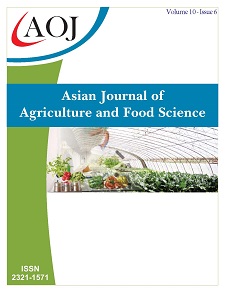Energy Profile in Broiler Chickens Fed with Different Levels of Humates
DOI:
https://doi.org/10.24203/ajafs.v10i6.7115Keywords:
Poultry digestion, Dry matter, Crude protein, Humic substancesAbstract
The objective of the study was the evaluation the effects of the peroral intake of humates (HS) added into feed mixtures on the energy metabolism of broiler chickens (Cobb 500). The selected parameters are concentrations of glucose, triglycerides and cholesterol analysed in the blood serum. There were used four groups of birds (A, B, C, negative control; n=120) in the experiment. Chickens were fed with ground diets (starter HYD1, grower HYD2, finisher HYD3) with supplements of HS from day 1 to 37 as follows A: Humac nature (HN) 7 g/kg, B: Humac nature monogastric (HNM) 7 g/kg, C: HNM 5 g/kg feed (Humac Ltd., Slovak Republic). The diets had the following content of crude protein: HYD1 230.20, HYD2 222.20, HYD3 209.40 g CP /kg dry matter). The statistical evaluation of results was performed by one-way analysis of variance and means were compared by the Student-Newman-Keuls test and correlation analysis. Higher concentrations (P<0.05) of triglycerides in blood serum were analyzed in groups A or B by 0.24 and 0.26 mmol/l, respectively, in comparison to the control group (y = 0.35830x + 0.58324). The values of cholesterol were at a lower level (P<0.05) in all 3 experimental groups by 1.07, 0.54 and 0.84 mmol/l (y = - 1.18073x + 2.75772). The positive effect of the intake of HS on glucose concentration was not confirmed when a higher concentration (P<0.05) was analyzed in the blood serum of the control group compared with groups A or C by 3.31 and 4.56 mmol/l (y = - 4.06420x + 13.37519), respectively.
References
Arif, M., Rehman, A., Abd El-Hack, M.E., Arain, M.A., Haseebarshad, M., Zakriaand, H.M., Abbasi, I.M., “Impacts of dietary humic acid supplementation on growth performance, some blood metabolites and carcass traits of broiler chicks”, Indian Journal of Animal Sciences, vol. 86, no. 9, pp. 1073-1078, 2016.
Arpášová, H., Pistová, V., Hrnčár, C., Fík, M., Haščík, P., “The impact of the humic acid and phytobiotics on performance and carcass parameters of broiler chickens”, Acta fytotechnica et zootechnica, vol. 21, no. 4, pp. 173-178, doi: 10.15414/afz.2018.21.04.173-178, 2018.
Bezuglova, O., “Molecular structure of humus acids in soils”, Journal of Plant Nutrition and Soil Science, vol. 182, pp. 676-682, doi: 10.1002/jpln.201900043, 2019.
Carvalho, L. H. M., De Koe, T., Tavares, P. B., “An improved molybdenum blue method for simultaneous determination of inorganic phosphate and arsenate”, Ecotoxicology and Environmental Restoration, vol. 1, no. 1, pp. 13–19, 1998.
Castanon, J.I.R., „History of the use of antibiotic as growth promoters in European poultry feeds”, Poultry Science, vol. 86, no. 11, pp. 2466–2471, doi:10.3382/ps.2007-00249, 2007.
Cunniff, P., Official Methods of Analysis of Association of Official Analytical Chemists, 16th edn., AOAC International, Airlington, Va, USA, 1995. ISBN: 9780935584547
Daněk, P., Paseka, A., Smola, J., Ondráček, J., Bečková, R., Rozkot, M., “Influence of lecithin emulsifier on the utilisation of nutrients and growth of piglets after weaning”, Czech Journal of Animal Science, vol. 50, no. 10, pp. 459–465, doi:10.17221/4245-CJAS, 2005.
Demeterová M., Mariščáková R., Pistl J., Naď P., Šamudovská A., “The effect of the probiotic strain Enterococcus faecium DSM 7134 in combination with natural humic substances on performance and health of broiler chickens”, Berliner und Münchener tierärztliche Wochenschrift, vol. 122, no. 9-10, pp. 370-377, doi:10.2376/0005-9366-122-370, 2009.
El-Ghany, W.A., Abdel-Latif, M.A., Hosny, F., Alatfeehy, N.M., Noreldin, A.E., Quesnell. R.R., Chapman, R., Sakai, L., Elbestawy, A.R., “Comparative efficacy of postbiotic, probiotic, and antibiotic against necrotic enteritis in broiler chickens”, Poultry Science, vol. 101, no. 8, 101988, doi: 10.1016/j.psj.2022.101988, 2022.
Elnaggar, A.Sh., El-Kelawy, M.I. “Effect of humic acid supplementation on productive performance, blood constituents, immune response and carcass characteristics of Sasso chicken”, Egyptian Journal of Animal Production, vol. 55, no. 1, pp. 75-84, doi:10.21608/EJAP.2018.93258, 2018.
European Commission, „Commission Regulation (EC) No 152/2009 of 27 January 2009 laying down the methods of sampling and analysis for the official control of feed”, Official Journal of European Union, vol. 54, pp. 1-130.
Hinkle, D.E., Wiersma, W., Jurs, S.G., Applied statistics for the behavioral sciences, Boston, USA: Houghton Mifflin, 756 pp., 2014. ISBN: 9780618124053
Konieczka, P., Józefiak, D., Kinsner, M., Smulikowska, S., “Effects of high-moisture corn preserved with organic acids combined with rapeseed meal and peas on performance and gut microbiota activity of broiler chickens”, Animal Feed Science and Technology, vol. 280, 115063. doi: 10.1016/j.anifeedsci.2021.115063, 2021.
Pineda-Quiroga, C., Atxaerandio, R., Ruiz, R., Garcia- Rodríguez, A., “Effects of dry whey powder alone or combined with calcium butyrate on productive performance, duodenal morphometry, nutrient digestibility, and ceca bacteria counts of broiler chickens”, Livestock Science, vol. 206, pp. 65–70, doi:10.1016/j.livci.2017.10.001, 2017.
Rath, N.C., Huff, W.E., Huff, G.R., “Effects of humic acid on broiler chickens. Poultry Science”, vol. 85, no. 3, pp. 410-414, doi:10.1093/ps/85.3.410, 2006.
Slominski, P., “Recent advances in research on enzymes for poultry diets”, Poultry Science, vol. 90, no. 9, pp. 2013-2023, . http://doi.org/10.3382/ps.2011-01372, 2011.
Van Loon, J. C., “Analytical Atomic Absorption Spectroscopy, Selected methods”, New York: Academic Press, New York, 348 pp, 1980. ISBN: 9780323154864
Van Soest, P. J., Robertson, J. B., Lewis, B. A., “Methods for dietary fiber, neutral detergent fiber, and nonstarch polysaccharides in relation to animal nutrition”, Journal of Dairy Science, vol. 74, no. 10, pp. 3583–3597, doi:10.3168/jds.S0022-0302(91)78551-2, 1991.
Downloads
Published
Issue
Section
License
Copyright (c) 2023 Andrej Marcin, Pavel Naď, Soňa Gancarčíková, Lukáš Bujňák, Magdaléna Skalická, František Zigo

This work is licensed under a Creative Commons Attribution-NonCommercial 4.0 International License.
Copyright © The Author(s). This article is published under the Creative Commons Attribution License (CC BY 4.0), which permits unrestricted use, distribution, and reproduction in any medium, provided the original work is properly cited.


